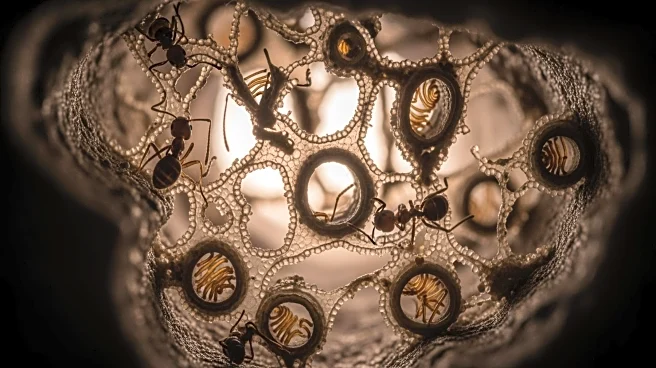What's Happening?
A study on the black garden ant, Lasius niger, reveals how these insects adapt their social behavior and nest architecture to mitigate the spread of disease. Behavioral ecologist Nathalie Stroeymeyt from
the University of Bristol has observed that infected ants self-isolate to prevent contaminating their nest mates. Healthy ants, particularly those caring for the queen and larvae, increase their distance from foragers who are more exposed to pathogens. The study, conducted with systems biologist Luke Leckie, used CT scans to show that ant colonies exposed to pathogens build nests that are more compartmentalized and less interconnected, which helps slow disease transmission. These findings, published in the journal Science, suggest that ants modify their environment in response to threats, a behavior previously undocumented outside of humans.
Why It's Important?
The study of ant behavior and nest architecture provides valuable insights into disease prevention strategies that could be applied to human public spaces. By understanding how ants protect vulnerable members and isolate sections of their colonies, urban planners and architects can design environments that minimize disease spread among humans. This concept of 'architectural immunity' could enhance public health infrastructure, especially in densely populated areas. The research highlights the potential for interdisciplinary approaches to improve societal resilience against epidemics, emphasizing the importance of integrating biological insights into human design practices.
What's Next?
The findings from this study may inspire further research into how other social species manage disease threats, potentially uncovering additional strategies applicable to human society. Urban planners and public health officials might explore collaborations with biologists to develop innovative designs for public spaces that incorporate principles of social immunity. As cities continue to grow and face challenges related to disease transmission, these insights could lead to new standards in architectural design that prioritize health and safety.
Beyond the Headlines
The study raises ethical considerations about how humans interact with and learn from nature. It challenges the traditional view of human superiority in problem-solving and highlights the importance of observing and respecting natural systems. This research could spark discussions on the ethical implications of biomimicry and the need for sustainable practices that align with ecological principles.











